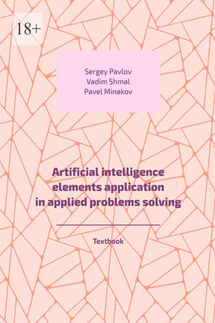© Sergey Pavlov, 2022
© Vadim Shmal, 2022
© Pavel Minakov, 2022
ISBN 978-5-0059-3991-3
Created with Ridero smart publishing system
Various subfields of AI research are centered around specific goals and the use of specific tools. Traditional AI research goals include reasoning, knowledge representation, planning, learning, natural language processing, perception. General intelligence (the ability to solve arbitrary tasks) is one of the long-term goals in this area. To solve these problems, AI researchers have adapted and integrated a wide range of problem-solving techniques, including search and mathematical optimization, formal logic, artificial neural networks, and methods based on statistics, probability, and economics. AI also draws on computer science, psychology, linguistics, philosophy, and many other fields. There is no single AI system that solves all problems or solves them effectively.
A key advantage of AI is its ability to solve problems in the real world. But, there are also many potential problems. An important task in the field of AI is to determine which of the possible problems are most likely to be solved with the help of AI, and which require different methods. Some of the main areas that contribute to solving complex AI problems are theory, engineering, and mathematics. While most AI researchers believe that AI will play an important role in future economic and technological development, there are many skeptics. Their skepticism includes concerns about the possible misuse of AI, concerns about its negative impact, and uncertainty about AI’s ability to solve real problems. However, this dispute is not the only one in this area. Many AI researchers believe that it is impossible to predict which tasks will be solved by AI in the future. The reasons for this are that while there are many important problems to be solved in the real world, there is no single mechanism or technology that solves them all.
At a high level, AI is the concept of computing systems that work with greater and greater complexity to understand, predict, and solve problems in the real world. This definition of AI is a definition of intelligence and is not limited to computer systems.
AI is a field of research that focuses on creating intelligent machines, devices, systems, algorithms, and so on. Computers are at the heart of AI, and an intelligent machine is designed to be able to efficiently solve problems in the real world.
To solve such problems, you can use many different algorithms and intelligent systems. A machine can be intelligent if it can perform intelligent tasks – this concept is different from an AI system, which has a certain set of rules, including the ability to learn, learn to perform intelligent tasks, and also have a long-term memory. All kinds of algorithms can be used to solve intellectual problems – learn how to behave, detect patterns and distinguish the real world from its simulations.
AI researchers believe that all intelligent systems can be improved by improving their ability to perform intelligent tasks – this is called algorithmic intelligence, or the ability of a machine to learn. However, there is some controversy in this area over the definition of intelligent machines, and the robustness and reliability of existing methods for designing and improving intelligent systems.
The path from a specific problem to an AI solution is called the «machine learning» process. Machine learning methods are a combination of an algorithm with a set of parameters and data, as well as a set of parameters and a set of data Examples of machine learning algorithms include machine learning in the form of neural networks that can identify patterns in the real world and classification systems that can identify different objects in a given set of images.
One of the important features of AI is that the quality of predictions can be improved by changing the parameters (called «features») and the data set (in the case of classification algorithms). For example, in the case of classification algorithms, if the dataset is based on the identification of different colors, then when the dataset changes, the predictions will change and can better predict the colors. This feature of machine learning plays a key role in understanding the accuracy of AI algorithms.
AI is a dynamic and rapidly evolving area of research with a wide range of different applications. There are several interpretations of AI. AI is not a single technology, but a whole range of technologies, in particular, machine learning, artificial neural networks, large-scale distributed systems, and so on. In particular, machine learning and deep learning are two different terms used in different disciplines. Machine learning is a method of applying machine learning algorithms to a machine that requires any kind of input, such as a car that will drive itself.
AI is commonly used to describe technology that uses information processing and information management principles such as computing, storing, routing, and processing input signals or information to make intelligent predictions or decisions – this is called artificial intelligence. AI has different definitions based on different fields of study and different applications.












